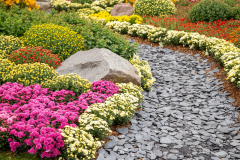Have you heard of rain gardens? They’re one of the biggest trends in gardening right now, the darling of social media feeds, and an eco-friendly project that virtually anyone can pull off. But is it right for your home? We talked to experts to find out more about the pros & cons.
Meet the experts
-
Ryan Fitzgerald, Realtor® and owner of Raleigh Realty in North Carolina
-
Loren Taylor, landscape expert and owner of Soothing Company, an online retailer or water fountains, hammocks, and other soothing things in Washington
-
Ursula Chanse, Senior Director of Bronx Green-Up and Community Horticulture at The New York Botanical Garden in New York
What the experts have to say about rain gardens
Our experts agree: While rain gardens are not something buyers ask for by name, there’s a growing interest in sustainable landscaping. “Buyers are not yet showing up asking for eco-features first, but when these features are presented in a way that blends beauty and practicality, they notice—and they remember,” explains Fitzgerald. He adds that this is especially true for buyers who have experienced drainage issues or higher water bills in the past and for families with children and pets.
Taylor observes that in states like Colorado, Utah, and Arizona, where water is limited, “the idea of managing water efficiently and using every drop well resonates with many homeowners.” He adds that rain gardens are also low maintenance, which is appealing to almost everyone. “People are increasingly looking for outdoor spaces that do not demand constant watering or mowing,” he adds. “They want to spend their time enjoying their garden, not fighting with it every weekend.”
Loading…
FAQs about rain gardens
What exactly is a rain garden?
Part of a larger rainscaping trend, a rain garden is a recessed area of native plants, trees, and shrubs designed to collect and temporarily hold stormwater before allowing the water to be reabsorbed into the ground.
What are the advantages of a rain garden?
The main benefit of a rain garden is that it reduces runoff, which contains contaminants that pollute waterways and degrade drinking water. They can also help prevent flooding, reduce standing water in a yard, improve soil quality, and attract butterflies, birds, and other wildlife. And it can contribute to curb appeal.
“If the rain garden looks like a muddy ditch, it will turn people off,” Fitzgerald says. “But if it blends seamlessly with native flowers and is clearly a part of a thoughtful landscape, buyers often ask about it and appreciate that it helps with water runoff during heavy storms.”
How much does it cost to add a rain garden?
As with all landscaping, pricing can vary greatly depending on the size of the garden, the type of plants, any additional soil needs, and whether you hire a pro or decide to do it





